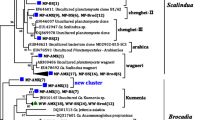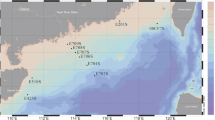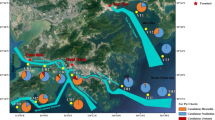Abstract
PCR primers targeting genes encoding the two proteins of anammox bacteria, hydrazine synthase and cytochrome c biogenesis protein, were designed and tested in this study. Three different ecotypes of samples, namely ocean sediments, coastal wetland sediments, and wastewater treatment plant (WWTP) samples, were used to assess the primer efficiency and the community structures of anammox bacteria retrieved by 16S ribosomal RNA (rRNA) and the functional genes. Abundances of hzsB gene of anammox bacteria in South China Sea (SCS) samples were significantly correlated with 16S rRNA gene by qPCR method. And hzsB and hzsC gene primer pair hzsB364f-hzsB640r and hzsC745f-hzsC862r in combination with anammox bacterial 16S rRNA gene primers were recommended for quantifying anammox bacteria. Congruent with 16S rRNA gene-based community study, functional gene hzsB could also delineate the coastal-ocean distributing pattern, and seawater depth was positively associated with the diversity and abundance of anammox bacteria from shallow- to deep-sea. Both hzsC and ccsA genes could differentiate marine samples between deep and shallow groups of the Scalindua sp. clades. As for WWTP samples, non-Scalindua anammox bacteria reflected by hzsB, hzsC, ccsA, and ccsB gene-based libraries showed a similar distribution pattern with that by 16S rRNA gene. NH4 + and NH4 +/Σ(NO3 − + NO2 −) positively correlated with anammox bacteria gene diversity, but organic matter contents correlated negatively with anammox bacteria gene diversity in SCS. Salinity was positively associated with diversity indices of hzsC and ccsB gene-harboring anammox bacteria communities and could potentially differentiate the distribution patterns between shallow- and deep-sea sediment samples. SCS surface sediments harbored considerably diverse community of Scalindua. A new Mai Po clade representing coastal estuary wetland anammox bacteria group based on 16S rRNA gene phylogeny is proposed. Existence of anammox bacteria within wider coverage of genera in Mai Po wetland indicates this unique niche is very complex, and species of anammox bacteria are niche-specific with different physiological properties towards substrates competing and chemical tolerance capability.








Similar content being viewed by others
References
Braak Ct, Šmilauer P (2002) CANOCO reference manual and CanoDraw for Windows user’s guide: software for canonical community ordination (version 4.5). Microcomputer Power, Ithaca, New York
Brandsma J, van de Vossenberg J, Risgaard-Petersen N, Schmid MC, Engstrom P, Eurenius K, Hulth S, Jaeschke A, Abbas B, Hopmans EC, Strous M, Schouten S, Jetten MSM, Damste JSS (2011) A multi-proxy study of anaerobic ammonium oxidation in marine sediments of the Gullmar Fjord, Sweden. Environ Microbiol Rep 3(3):360–366. doi:10.1111/j.1758-2229.2010.00233.x
Broda E (1977) Two kinds of lithotrophs missing in nature. Z Allg Mikrobiol 17(6):491–493
Byrne N, Strous M, Crepeau V, Kartal B, Birrien J-L, Schmid M, Lesongeur F, Schouten S, Jaeschke A, Jetten M, Prieur D, Godfroy A (2009) Presence and activity of anaerobic ammonium-oxidizing bacteria at deep-sea hydrothermal vents. ISME J 3(1):117–123. doi:10.1038/ismej.2008.72
Cao H, Hong Y, Li M, Gu J-D (2011a) Diversity and abundance of ammonia-oxidizing prokaryotes in sediments from the coastal Pearl River estuary to the South China Sea. Antonie Van Leeuwenhoek 100(4):545–556
Cao H, Hong Y, Li M, Gu J-D (2011b) Phylogenetic diversity and ecological pattern of ammonia-oxidizing archaea in the surface sediments of the Western Pacific. Microb Ecol 62(4):813–823
Cao H, Li M, Hong Y, Gu J-D (2011c) Diversity and abundance of ammonia-oxidizing archaea and bacteria in polluted mangrove sediment. Syst Appl Microbiol 34(7):513–523
Chan HW, Meng H, Gu J-D (2016) Anammox bacteria detected in fish intestinal tract systems. Appl Environ Biotechnol 1(1):13-18 doi:10.18063/AEB.2016.01.010
Dai M, Wang L, Guo X, Zhai W, Li Q, He B, Kao S-J (2008) Nitrification and inorganic nitrogen distribution in a large perturbed river/estuarine system: the Pearl River Estuary, China. Biogeosci Disc 5(2):1545–1585
Dale OR, Tobias CR, Song B (2009) Biogeographical distribution of diverse anaerobic ammonium oxidizing (anammox) bacteria in Cape Fear River Estuary. Environ Microbiol 11(5):1194–1207
Dalsgaard T, Canfield DE, Petersen J, Thamdrup B, Acuna-Gonzalez J (2003) N2 production by the anammox reaction in the anoxic water column of Golfo Dulce, Costa Rica. Nature 422(6932):606–608. doi:10.1038/nature01526
Ferousi C, Speth DR, Reimann J, den Camp HJO, Allen JW, Keltjens JT, Jetten MS (2013) Identification of the type II cytochrome c maturation pathway in anammox bacteria by comparative genomics. BMC Microbiol 13(1):265
Frawley ER, Kranz RG (2009) CcsBA is a cytochrome c synthetase that also functions in heme transport. Proc Natl Acad Sci U S A 106(25):10201–10206
Gori F, Tringe SG, Kartal B, Marchiori E, Machiori E, Jetten M (2011) The metagenomic basis of anammox metabolism in Candidatus ‘Brocadia fulgida’. Biochem Soc Trans 39(6):1799–1804
Güven D, Dapena A, Kartal B, Schmid MC, Maas B, van de Pas-Schoonen K, Sozen S, Mendez R, den Camp HJO, Jetten MS (2005) Propionate oxidation by and methanol inhibition of anaerobic ammonium-oxidizing bacteria. Appl Environ Microbiol 71(2):1066–1071
Hamady M, Lozupone C, Knight R (2009) Fast UniFrac: facilitating high-throughput phylogenetic analyses of microbial communities including analysis of pyrosequencing and PhyloChip data. ISME J 4(1):17–27
Han P, Gu J-D (2013) More refined diversity of anammox bacteria recovered and distribution in different ecosystems. Appl Microbiol Biotechnol 97(8):3653–3663
Harhangi HR, Le Roy M, van Alen T, Hu B-l, Groen J, Kartal B, Tringe SG, Quan Z-X, Jetten MS, den Camp HJO (2012) Hydrazine synthase, a unique phylomarker with which to study the presence and biodiversity of anammox bacteria. Appl Environ Microbiol 78(3):752–758
Hira D, Toh H, Migita CT, Okubo H, Nishiyama T, Hattori M, Furukawa K, Fujii T (2012) Anammox organism KSU-1 expresses a NirK-type copper-containing nitrite reductase instead of a NirS-type with cytochrome cd 1. FEBS Lett 586(11):1658–1663
Hirsch MD, Long ZT, Song B (2011) Anammox bacterial diversity in various aquatic ecosystems based on the detection of hydrazine oxidase genes (hzoA/hzoB). Microb Ecol 61(2):264–276
Hong Y-G, Li M, Cao H, Gu J-D (2011) Residence of habitat-specific anammox bacteria in the deep-sea subsurface sediments of the South China Sea: analyses of marker gene abundance with physical chemical parameters. Microb Ecol 62(1):36–47
Hu B-l, Rush D, van der Biezen E, Zheng P, van Mullekom M, Schouten S, Damste JSS, Smolders AJP, Jetten MSM, Kartal B (2011a) New anaerobic, ammonium-oxidizing community enriched from peat soil. Appl Environ Microbiol 77(3):966–971. doi:10.1128/aem.02402-10
Hu B, Shen L, Xu X, Zheng P (2011b) Anaerobic ammonium oxidation (anammox) in different natural ecosystems. Biochem Soc Trans 39(6):1811
Hu Z, Speth DR, Francoijs K-J, Quan Z-X, Jetten M (2012) Metagenome analysis of a complex community reveals the metabolic blueprint of anammox bacterium “Candidatus Jettenia asiatica”. Front Microbio 3. doi:10.3389/fmicb.2012.00366
Humbert S, Zopfi J, Tarnawski SE (2012) Abundance of anammox bacteria in different wetland soils. Environ Microbiol Rep 4(5):484–490. doi:10.1111/j.1758-2229.2012.00347.x
Jetten MSM, Strous M, van de Pas-Schoonen KT, Schalk J, van Dongen U, van de Graaf AA, Logemann S, Muyzer G, van Loosdrecht MCM, Kuenen JG (1998) The anaerobic oxidation of ammonium. FEMS Microbiol Rev 22(5):421–437. doi:10.1016/s0168-6445(98)00023-0
Jetten MSM, Sliekers O, Kuypers M, Dalsgaard T, van Niftrik L, Cirpus I, van de Pas-Schoonen K, Lavik G, Thamdrup B, Le Paslier D, Op den Camp HJM, Hulth S, Nielsen LP, Abma W, Third K, Engstrom P, Kuenen JG, Jorgensen BB, Canfield DE, Damste JSS, Revsbech NP, Fuerst J, Weissenbach J, Wagner M, Schmidt I, Schmid M, Strous M (2003) Anaerobic ammonium oxidation by marine and freshwater planctomycete-like bacteria. Appl Microbiol Biotechnol 63(2):107–114. doi:10.1007/s00253-003-1422-4
Jetten MS, Lv N, Strous M, Kartal B, Keltjens JT, Op den Camp HJ (2009) Biochemistry and molecular biology of anammox bacteria. Crit Rev Biochem Mol Biol 44(2–3):65–84
Junier P, Molina V, Dorador C, Hadas O, Kim O-S, Junier T, Witzel K-P, Imhoff JF (2010) Phylogenetic and functional marker genes to study ammonia-oxidizing microorganisms (AOM) in the environment. Appl Microbiol Biotechnol 85(3):425–440
Kartal B, Rattray J, van Niftrik LA, van de Vossenberg J, Schmid MC, Webb RI, Schouten S, Fuerst JA, Damsté JS, Jetten MS (2007) Candidatus “Anammoxoglobus propionicus” a new propionate oxidizing species of anaerobic ammonium oxidizing bacteria. Syst Appl Microbiol 30(1):39–49
Kartal B, Geerts W, Jetten MS (2011a) Cultivation, detection, and ecophysiology of anaerobic ammonium-oxidizing bacteria. Methods Enzymol 486(Part A):89–108
Kartal B, Maalcke WJ, de Almeida NM, Cirpus I, Gloerich J, Geerts W, den Camp HJO, Harhangi HR, Janssen-Megens EM, Francoijs K-J (2011b) Molecular mechanism of anaerobic ammonium oxidation. Nature 479(7371):127–130
Kranz RG, Richard-Fogal C, Taylor J-S, Frawley ER (2009) Cytochrome c biogenesis: mechanisms for covalent modifications and trafficking of heme and for heme-iron redox control. Microbiol Mol Biol Rev 73(3):510–528
Kuenen JG (2008) Anammox bacteria: from discovery to application. Nat Rev Microbiol 6(4):320–326
Kuypers MMM, Lavik G, Woebken D, Schmid M, Fuchs BM, Amann R, Jorgensen BB, Jetten MSM (2005) Massive nitrogen loss from the Benguela upwelling system through anaerobic ammonium oxidation. Proc Natl Acad Sci U S A 102(18):6478–6483. doi:10.1073/pnas.0502088102
Lam P, Lavik G, Jensen MM, van de Vossenberg J, Schmid M, Woebken D, Gutiérrez D, Amann R, Jetten MS, Kuypers MM (2009) Revising the nitrogen cycle in the Peruvian oxygen minimum zone. Proc Natl Acad Sci U S A 106(12):4752–4757
Lau S, Chu L (1999) Water quality degradation at the Mai Po Marshes Nature Reserve (Hong Kong) with reference to nutrient enrichment. Hydrobiologia 403:195–203. doi:10.1023/A:1003759215909
Li M, Gu J-D (2011) Advances in methods for detection of anaerobic ammonium oxidizing (anammox) bacteria. Appl Microbiol Biotechnol 90(4):1241–1252
Li M, Gu J-D (2016) Molecular evidence of the existence of anaerobic ammonia oxidation bacteria in the gut of polychaete (Neanthes glandicincta). Appl Environ Biotechnol 1(1):19–29 doi:10.1820063/AEB.2016.01.011
Li H, Chen S, Mu B-Z, Gu J-D (2010a) Molecular detection of anaerobic ammonium-oxidizing (anammox) bacteria in high-temperature petroleum reservoirs. Microb Ecol 60(4):771–783. doi:10.1007/s00248-010-9733-3
Li M, Hong Y, Klotz MG, Gu J-D (2010b) A comparison of primer sets for detecting 16S rRNA and hydrazine oxidoreductase genes of anaerobic ammonium-oxidizing bacteria in marine sediments. Appl Microbiol Biotechnol 86(2):781–790
Li M, Cao H, Hong Y-G, Gu J-D (2011a) Seasonal dynamics of anammox bacteria in estuarial sediment of the Mai Po nature reserve revealed by analyzing the 16S rRNA and hydrazine oxidoreductase (hzo) Genes. Microbes Environ 26(1):15–22. doi:10.1264/jsme2.ME10131
Li M, Ford T, Li X, Gu J-D (2011b) Cytochrome cd1-containing nitrite reductase encoding gene nirS as a new functional biomarker for detection of anaerobic ammonium oxidizing (Anammox) bacteria. Environ Sci Technol 45(8):3547–3553
Li M, Hong Y-G, Cao H-L, Gu J-D (2011c) Mangrove trees affect the community structure and distribution of anammox bacteria at an anthropogenic-polluted mangrove in the Pearl River Delta reflected by 16S rRNA and hydrazine oxidoreductase (HZO) encoding gene analyses. Ecotoxicology 20(8):1780–1790
Li M, Cao H, Hong Y, Gu J-D (2013a) Using the variation of anammox bacteria community structures as a bio-indicator for anthropogenic/terrestrial nitrogen inputs in the Pearl River Delta (PRD). Appl Microbiol Biotechnol 97(22):9875–9883
Li M, Hong Y, Cao H, Gu J-D (2013b) Community structures and distribution of anaerobic ammonium oxidizing and nirS-encoding nitrite-reducing bacteria in surface sediments of the South China Sea. Microb Ecol:1–16
Liang Y, Wong MH (2003) Spatial and temporal organic and heavy metal pollution at Mai Po Marshes Nature Reserve, Hong Kong. Chemosphere 52(9):1647–1658
Moore TA, Xing Y, Lazenby B, Lynch MDJ, Schiff S, Robertson WD, Timlin R, Lanza S, Ryan MC, Aravena R, Fortin D, Clark ID, Neufeld JD (2011) Prevalence of anaerobic ammonium-oxidizing bacteria in contaminated groundwater. Environ Sci Technol 45(17):7217–7225. doi:10.1021/es201243t
Motulsky H (1999) Analyzing data with GraphPad prism. GraphPad Software Incorporated
Mulder A, Graaf A, Robertson L, Kuenen J (1995) Anaerobic ammonium oxidation discovered in a denitrifying fluidized bed reactor. FEMS Microbiol Ecol 16(3):177–184
Oshiki M, Shimokawa M, Fujii N, Satoh H, Okabe S (2011) Physiological characteristics of the anaerobic ammonium-oxidizing bacterium ‘Candidatus Brocadia sinica’. Microbiology 157(6):1706–1713. doi:10.1099/mic.0.048595-0
Quan ZX, Rhee SK, Zuo JE, Yang Y, Bae JW, Park JR, Lee ST, Park YH (2008) Diversity of ammonium-oxidizing bacteria in a granular sludge anaerobic ammonium-oxidizing (anammox) reactor. Environ Microbiol 10(11):3130–3139
Schloss PD, Westcott SL, Ryabin T, Hall JR, Hartmann M, Hollister EB, Lesniewski RA, Oakley BB, Parks DH, Robinson CJ (2009) Introducing mothur: open-source, platform-independent, community-supported software for describing and comparing microbial communities. Appl Environ Microbiol 75(23):7537–7541
Schmid M, Walsh K, Webb R, Rijpstra WI, van de Pas-Schoonen K, Verbruggen MJ, Hill T, Moffett B, Fuerst J, Schouten S (2003) Candidatus “Scalindua brodae”, sp. nov., Candidatus “Scalindua wagneri”, sp. nov., two new species of anaerobic ammonium oxidizing bacteria. Syst Appl Microbiol 26(4):529–538
Schmid MC, Maas B, Dapena A, van de Pas-Schoonen K, van de Vossenberg J, Kartal B, Van Niftrik L, Schmidt I, Cirpus I, Kuenen JG (2005) Biomarkers for in situ detection of anaerobic ammonium-oxidizing (anammox) bacteria. Appl Environ Microbiol 71(4):1677–1684
Schmid MC, Risgaard-Petersen N, Van De Vossenberg J, Kuypers MM, Lavik G, Petersen J, Hulth S, Thamdrup B, Canfield D, Dalsgaard T (2007) Anaerobic ammonium-oxidizing bacteria in marine environments: widespread occurrence but low diversity. Environ Microbiol 9(6):1476–1484
Schmid MC, Hooper AB, Klotz MG, Woebken D, Lam P, Kuypers MM, Pommerening-Roeser A, Op Den Camp HJ, Jetten MS (2008) Environmental detection of octahaem cytochrome c hydroxylamine/hydrazine oxidoreductase genes of aerobic and anaerobic ammonium-oxidizing bacteria. Environ Microbiol 10(11):3140–3149
Speth DR, Russ L, Kartal B, Op den Camp HJ, Dutilh BE, Jetten MS (2015) Draft genome sequence of anammox bacterium “Candidatus Scalindua brodae”, obtained using differential coverage binning of sequencing data from two reactor enrichments. Genome Announc 3(1):e01415–e01414
Steffan RJ, Atlas RM (1991) Polymerase chain reaction: applications in environmental microbiology. Annu Rev Microbiol 45(1):137–161. doi:10.1146/annurev.mi.45.100191.001033
Strous M, Fuerst JA, Kramer EH, Logemann S, Muyzer G, van de Pas-Schoonen KT, Webb R, Kuenen JG, Jetten MS (1999) Missing lithotroph identified as new planctomycete. Nature 400(6743):446–449
Strous M, Pelletier E, Mangenot S, Rattei T, Lehner A, Taylor MW, Horn M, Daims H, Bartol-Mavel D, Wincker P (2006) Deciphering the evolution and metabolism of an anammox bacterium from a community genome. Nature 440(7085):790–794
Sun W, Xu MY, Wu WM, Guo J, Xia CY, Sun GP, Wang AJ (2014) Molecular diversity and distribution of anammox community in sediments of the Dongjiang River, a drinking water source of Hong Kong. J Appl Microbiol 116(2):464–476. doi:10.1111/jam.12367
Tamura K, Peterson D, Peterson N, Stecher G, Nei M, Kumar S (2011) MEGA5: molecular evolutionary genetics analysis using maximum likelihood, evolutionary distance, and maximum parsimony methods. Mol Biol Evol 28(10):2731–2739
Thamdrup B, Dalsgaard T (2002) Production of N2 through anaerobic ammonium oxidation coupled to nitrate reduction in marine sediments. Appl Environ Microbiol 68(3):1312–1318. doi:10.1128/aem.68.3.1312-1318.2002
Thamdrup B, Dalsgaard T, Jensen MM, Ulloa O, Farias L, Escribano R (2006) Anaerobic ammonium oxidation in the oxygen-deficient waters off northern Chile. Limnol Oceanogr 51(5):2145–2156
van de Vossenberg J, Rattray JE, Geerts W, Kartal B, van Niftrik L, van Donselaar EG, Damste JSS, Strous M, Jetten MSM (2008) Enrichment and characterization of marine anammox bacteria associated with global nitrogen gas production. Environ Microbiol 10(11):3120–3129. doi:10.1111/j.1462-2920.2008.01643.x
van de Vossenberg J, Woebken D, Maalcke WJ, Wessels HJ, Dutilh BE, Kartal B, Janssen-Megens EM, Roeselers G, Yan J, Speth D (2012) The metagenome of the marine anammox bacterium ‘Candidatus Scalindua profunda’ illustrates the versatility of this globally important nitrogen cycle bacterium. Environ Microbiol
Wang J, Gu J-D (2013a) Dominance of Candidatus Scalindua species in anammox community revealed in soils with different duration of rice paddy cultivation in Northeast China. Appl Microbiol Biotechnol 97(4):1785–1798. doi:10.1007/s00253-012-4036-x
Wang Y-F, Gu J-D (2013b) Higher diversity of ammonia/ammonium-oxidizing prokaryotes in constructed freshwater wetland than natural coastal marine wetland. Appl Microbiol Biotechnol 97(15):7015–7033. doi:10.1007/s00253-012-4430-4
Wang S, Zhu G, Peng Y, Jetten MS, Yin C (2012a) Anammox bacterial abundance, activity, and contribution in riparian sediments of the Pearl River estuary. Environ Sci Technol 46(16):8834–8842
Wang Y, Zhu G, Harhangi HR, Zhu B, Jetten MS, Yin C, Op den Camp HJ (2012b) Co-occurrence and distribution of nitrite-dependent anaerobic ammonium and methane-oxidizing bacteria in a paddy soil. FEMS Microbiol Lett 336(2):79–88
Wang Y-F, Feng Y-Y, Ma X, Gu J-D (2013) Seasonal dynamics of ammonia/ammonium-oxidizing prokaryotes in oxic and anoxic wetland sediments of subtropical coastal mangrove. Appl Microbiol Biotechnol 97(17):7919–7934. doi:10.1007/s00253-012-4510-5
Woebken D, Lam P, Kuypers MM, Naqvi SW, Kartal B, Strous M, Jetten MS, Fuchs BM, Amann R (2008) A microdiversity study of anammox bacteria reveals a novel Candidatus Scalindua phylotype in marine oxygen minimum zones. Environ Microbiol 10(11):3106–3119. doi:10.1111/j.1462-2920.2008.01640.x
Wright ES, Yilmaz LS, Noguera DR (2012) DECIPHER, a search-based approach to chimera identification for 16S rRNA sequences. Appl Environ Microbiol 78(3):717–725
Yoshinaga I, Amano T, Yamagishi T, Okada K, Ueda S, Sako Y, Suwa Y (2011) Distribution and diversity of anaerobic ammonium oxidation (anammox) bacteria in the sediment of a eutrophic freshwater lake, Lake Kitaura, Japan. Microbes Environ 26(3):189–197. doi:10.1264/jsme2.ME10184
Zhu G, Wang S, Wang Y, Wang C, Risgaard-Petersen N, Jetten MS, Yin C (2011) Anaerobic ammonia oxidation in a fertilized paddy soil. ISME J 5(12):1905–1912
Acknowledgments
This research was supported by a postgraduate student studentship from The University of Hong Kong (ZZ) and fund from RGC GRF grant No. 701913 (J-DG). Kelly Lau was thanked for laboratory assistance and technical support.
Author information
Authors and Affiliations
Corresponding author
Ethics declarations
Funding
This study was funded by the RGC GRF grant no. 701913 (J-DG) and a Hong Kong PhD fellowship (ZZ).
Conflict of interest
The authors declare that they have no conflict of interest.
Ethical approval
This article does not contain any studies with human participants or animals performed by any of the authors.
Electronic supplementary material
ESM 1
(4.61 MB)
Rights and permissions
About this article
Cite this article
Zhou, Z., Chen, J., Meng, H. et al. New PCR primers targeting hydrazine synthase and cytochrome c biogenesis proteins in anammox bacteria. Appl Microbiol Biotechnol 101, 1267–1287 (2017). https://doi.org/10.1007/s00253-016-8013-7
Received:
Revised:
Accepted:
Published:
Issue Date:
DOI: https://doi.org/10.1007/s00253-016-8013-7




